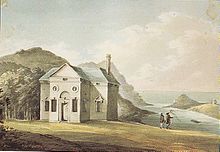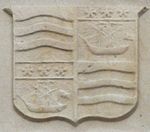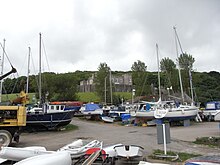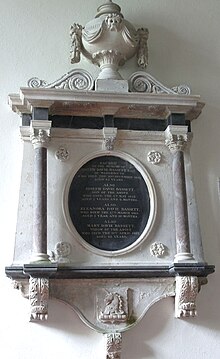Watermouth Castle
Watermouth Castle is a medieval castle-style country house in the hamlet of Watermouth near Ilfracombe in the north of the English county of Devon . The Bassett family residence was designed by architect George Whightwick in the mid-19th century and completed in 1825. English Heritage has the house as a historical building II *. Grade listed.
Located near the waterfront on Watermouth Inlet, the house is home to a collection of Victorian home appliance and gaming machine antiques , a family theme park and vacation rentals. The Bassett family left the house in 1945.
owner
The bassets
Joseph Davie Bassett

The villa was Joseph Davie Bassett (1764-1846), son of John Davie († 1793) from Orleigh Court , in Buckland Brewer built. He was the 3rd descendant of the tobacco dealer John Davie († 1710) from Orleigh Court and his wife, Eleonora Basset from Heanton Court in Heanton Punchardon . His brother was Reverend Charles Davie (1760-1836), rector of Heanton Punchardon whose church patronage the family Bassett had. After his mother was the sole heir to her brother Francis Bassett († 1802), son of John Francis Bassett (1714–1757), 1740–1741 Member of Parliament for Barnstaple, and his wife Eleanor Courtenay († 1765), daughter of Sir William Courtenay, 2 . Baronet , († 1735) from Powderham Castle , Joseph Davie took the name Bassett as a patronymic and adopted the heraldic symbols of the Bassett in his coat of arms. He sold Orleigh Court in 1807 and had Watermouth Castle built as his primary residence. He married Mary Irwin (1777-1862) from Barnstaple . The couple's tomb is preserved in Berrymarbor Church .
Visit from John Swete

The topographer Reverend John Swete visited Watermouth prior to the construction of the Georgian country house in the course of his 1796 travels and was Mr. Davie's guest. He painted the Palladian house that was then on the site and wrote about his visit in his diary:
“From the top of a high point of land along the edge of which we passed, I descended to Watermouth, the sight of which was as unique as it was uplifting. All these reasons were circumscribed in a small space that consisted of a few fields that belonged to the house and a peninsula which, when it was enclosed between the waters of the bay and the sea, at first had a certain width and good grazing ground depicted. This, however, soon contracted and gradually became narrower, limited in length to the west by a rocky point, which dared to enter the sea opposite a vast cliff that fell steeply and rocky on the other side, and so the mouth of a small bay whose beauty and uniqueness were the pride of this place. At that point it was very narrow; but the space between the rocky barriers widened the further inland they were followed, and was widest at their end, where a row of fishermen's huts could be seen and where on a distant, elevated hill was Mr. Davie's seat. The previous sketch explains the nature of this bay and the headlands that surround it better, and it gives a more precise idea of the location and architecture of the house. But I found this in a dilapidated state, into which it had been intentionally brought with a view to expanding it. I had just finished the rough outline of it when a servant brought me his master's compliments and asked me to attend the dinner that was on the table. It was three o'clock, I accepted the invitation, as I was in a hurry, and followed the servant down to the fisherman's hut, where Mr. Davie had temporarily stopped (during the renovation of his house). I was welcomed in a friendly and polite manner. In the evening, when we had had our wine, he and his brother accompanied me to the house, which I found required only a few additions, the largest of which were two arched windows on the north and south facades; these were the main rooms, drawing room and dining room. They were small at the time and according to the proposed plan it seemed that not only should it be enlarged, but the view should be improved as well. Almost the only view from the windows was of the bay and its immediate surroundings, but there would now be a wider view on the north side; the whole Combemartyn coast would be surveyed, especially the pointed hill which I almost called a mountain before I wrote it down under the name Hangman's Cliff . There was a certain grandeur here, approaching grandeur, which, in stark contrast to the view of the bay, could not avoid attracting the eye of a man with good taste like Mr Davie seemed to me. In fact, the introduction of this beautiful point in the views from the house seemed to me to be of the first consequence and it was astonishing that the whole house should have been empty in that direction. The original building was small and simple in itself, in the way that it had a kind of monastic corridor underground, where the offices were located and around which it wound in a multitude of labyrinthine curves. It was built on a plan by Lord Clinton (as Mr Davie told me), who was a relative of the family. This gentleman was so captivated by the Greek architectural style on his travels that when he returned to England he was seized by a building craze and by seeing his compatriots in the west in examples of the elegant temples and buildings that he had seen and admired abroad to introduce. Vitruvius and Palladio were the grandmasters, and their models were used to create the temples of Castle Hill , his residence, and the small country house at Watermouth. It is not uncommon to see manors of this shape in the London area, but at least our surprise is aroused when we see this type of architecture in the middle of such a wild country. One would have expected to see an old, Gothic country house, as this is more adapted to the country and the romantic location of Watermouth. "
Monument to Joseph Davie Bassett
The grave slab of Joseph Davie Bassett (1764-1846), the builder of Watermouth Castle, his wife and two underage children is set into the wall at the east end of the south wing of the church in Berrymarbor . In the middle of the circle it says:
“Consecrated in memory of Joseph Davie Bassett Esq.r of Watermouth, who died on December 10, 1846 at the age of 82. Also Joseph Davie Bassett, son of the above, who died May 1, 1812 at the age of 2 years and 6 months. Also Eleanora Davie Bassett, who died on March 17, 1813 at the age of 1 year and 10 months. Also Mary Davie Bassett, widow of the above, who died on April 21, 1862 at the age of 85. "
Davie Bassett descendants

|

|
|
|
Left : Old coat of arms of the Bassetts: six horizontal waves gold and red . This coat of arms can be seen on four 17th century tombstones in the church of Heanton Punchardon . On the right a coat of arms on a pinnacle above the main entrance hall of Watermouth Castle with the coat of arms of the Bassetts , sprinkled with that of the Davies.
|
||
The eldest son and heir to Joseph Davie Bassett was Arthur Davie Bassett (1801-1870), who died on December 8, 1870 in a riding accident. He married Harriet Sarah Crawfurth , daughter of Thomas Smith Crawfurth from Dulverton , with whom he had his eldest, surviving son, Reverend Arthur Crawfurth Davie Bassett (1830-1880), who remained unmarried and died at Watermouth Castle. He had a brother, Francis Courtenay Bassett , who died in 1839 at the age of less than 1 year, and two sisters, Harriet , whom he made his heir, and Eleanora Susanna Bassett (1842-1881), who died unmarried and whose tomb, a stained stained glass window, seen in Barrymarbor Church . Arthur Davie Bassett's heiress was thus his sister Harriet Mary Bassett, who on January 7, 1858, married Charles Henry Williams (1834-1908), MP from Pilton House in Pilton near Barnstaple .
Williams Bassett
To the family Williams pub recalls Williams Arms in the municipality Heanton Punchardon on the road between Barnstaple and Braunton . As a condition of the inheritance of his wife, Charles Henry Williams conditioned himself, his wife and their descendants by royal permission of October 11, 1880, to adopt the name Bassett as the patronymic and the coat of arms of the Bassets:
London Gazette, October 15, 1880: Whitehall, October 11, 1880
The Queen deigned, Charles Henry Williams of Pilton House in Barnstaple, Devon, Esq., And Harriet Mary, his wife, elder of Arthur's two daughters Davie-Bassett of Umberleigh in the parish of Atherington and Watermouth Castle in the town of Berrymarbor, both in Devon, and sister and co-heiress of Arthru Crawfurth Davie-Bassett of Umberleigh and Watermouth Castle, as aforesaid, an employee in the Holy Orders , all deceased to give their royal permission and authority that they may only accept and continue to use the surname Bassett in place of Williams, and that he, the said Charles Henry Williams, may bear the Bassett's coat of arms, and that this surname and coat of arms in may be accepted, carried and used in the same way by their legitimate offspring. This coat of arms must first be properly displayed in accordance with the Coat of Arms Act and recorded in the College of Arms , otherwise the said royal permission and approval is invalid and without effect. It is also ordered that said royal concession and declaration be registered in Her Majesty's said College of Arms. "
New Williams Bassetts coat of arms
The coat of arms that he adopted is defined as follows: six horizontal waves gold and red, in the middle above a red clover leaf cross . Helmet jewel: on a wreath of colors the silver head of a unicorn, the mane, the beard and the horn gold, on the neck two serrated stripes in red and as a distinction with a red cross on all four bars . Motto: Bene agere ac Laetari ( Eng .: "Act well and be happy"). His properties were at Pilton House in Barnstaple, Umberleigh House in Atherington, and Watermouth Castle in Berrymarbor, all in Devon.
Williams-Bassett descendants
They had the following descendants:

- Walter Bassett Bassett (1864–1907), b. Walter Basset Williams, Lieutenant in the Royal Navy , engineer and pioneer in the construction of Ferris wheels , who died almost bankrupt. He died before his father and so never inherited the family estate. He built the Vienna Giant Ferris Wheel in 1897, which is still standing today. For a long time it was the largest Ferris wheel in the world and was erected on the occasion of the 50th anniversary of the throne of Emperor Franz Joseph I of Austria . He married Ellen Caroline Charlotte Dowell , daughter of Admiral Sir William Montagu Dowell , on November 18, 1890 . The couple had no offspring.
- Edith Bassett Bassett (1862–1943), b. Edith Basset Williams, married on October 18, 1882 in the Curzon Chapel in Mayfair (London) Captain Ernest Charles Penn Curzon (1856–1938), son of Col. Hon. Ernest George Curzon , son of Richard Curzon-Howe, 1st Earl Howe . She received the Order of the British Empire in 1918 . The couple had a son and two daughters. After the death of her father in 1908, she inherited all of the Bassett's estates, including Watermouth Castle and the manor of Berrymarbor . During World War I she began to sell the Bassett's lands, and in 1917 also Umberleigh House and the associated manor. Watermouth Castle served as a military hospital during World War I and began selling the farms and cottages in Berrymarbor in the 1920s. In 1942 she sold most of the contents of Watermouth Castle. Her portrait is still hanging in the Berrymarbor Community Hall today .
Wickenden
The country house passed through the hands of many short-term owners and real estate speculators, but was eventually bought by Keith Wickenden (1932-1983), a Conservatives MP for Dorking South, chairman of European Ferries , holding the Townsend Thoresen Ferries , owner of the port of Watermouth and Director of Brighton & Hove Albion FC. He died in 1983 when a light aircraft crashed near Shoreham airfield . Keith Wickenden and his brother Roland had George Nott Industries transferred to the 1970th The shares of European Ferries were taken over by P&O Ferries in 1987, just before the Herold of Free Enterprise off Zeebrugge . Brother Alan Wickenden managed a holiday camp for him in North Devon until the early 1980s.
Haines
In 1977 Richard L. Haines of Market Deeping in Cambridgeshire and his Dutch wife, daughter of a flower grower named Derick van Daalen , bought Watermouth Castle from Keith Wickenden. The purchase price for the cottage and 24 acres of land was £ 50,000. The country house was then converted into an amusement center currently run by the couple's two sons, Jonathan and Antonie Haines .
today
The country house is a tourist attraction and open to the public for an entrance fee. In the country house you will find the areas Castle Treasure , Dungeon Labyrinths and Watershow Extravaganza . There are nine rides on the property in themed areas called Adventure Land , Merry go Land, and Gnome Land .
Individual references and comments
- ^ Watermouth Castle, Including Front Retaining Wall and Rear Courtyard Walls . Images of England. Historic England. English Heritage. Retrieved November 23, 2016.
- ^ WH Rogers: Buckland Brewer . 1938. pp. 53-54.
- ↑ The grave book of the church in Heanton Punchardon is on display in the church. Charles Davie was buried on February 12, 1836 after he died at the age of 76.
- ^ WH Rogers: Buckland Brewer . 1938. pp. 52-53.
- ↑ Todd Gray, Margery Rowe (Editor): Travels in Georgian Devon in The Illustrated Journals of the Reverend John Swete, 1789-1800 . Volume 3. Tiverton 1999. pp. 86-88.
- ^ Hugh Fortescue, 1st Earl of Clinton, 14th Baron Clinton (1696-1751).
- ^ Baily's Magazine of Sports and Pastimes . No. 380 (October 1891). Issue 56.
- ^ London Gazette (October 15, 1880). P. 5285
- ↑ Arthur Charles Fox-Davies: Armorial families: a Directory of Gentlemen of Coat-Armor . Retrieved November 24, 2016.
- ^ P. Everard. P. 31.
- ↑ of which it is (incorrectly) claimed that he was the grandson of “Colonel Bassett”, master 1775–1784. However, the two possible persons mentioned above had no male offspring, which makes such a relationship impossible.
- ↑ Rawdon Briggs Lee: A History And Description Of The Modern Dogs Of Great Britain And Ireland (Sporting Division) . 1897.
- ^ Watermouth Castle . Devon Heritage. Retrieved November 24, 2016.
- ^ Obituary in Accountancy Magazine (August 1983).
Web links
Coordinates: 51 ° 12 ′ 48 " N , 4 ° 4 ′ 49" W.






